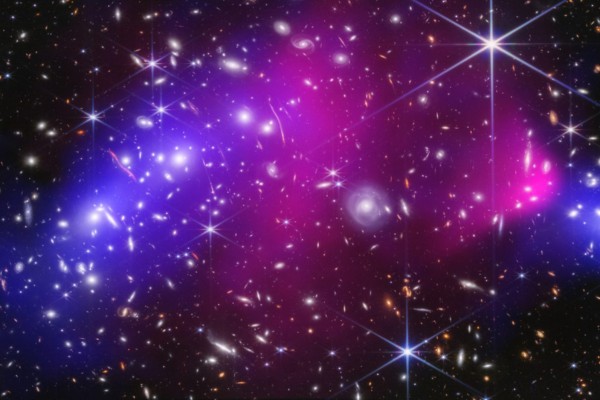
The central region of the Bullet Cluster observed by the Webb telescope in infrared and by Chandra in X-rays: galaxies and stars are visible, hot gas is shown in pink, and dark matter is mapped in blue. ©Nasa, Esa, Csa, StscI, Cxc
|
|
|
In the dark side of the
universe: the axion hypothesis
|
|
|
It does not emit or absorb electromagnetic radiation, i.e. it cannot be detected by our telescopes; it interacts very little with the atoms of ordinary matter; it is so exotic that it has no place on the periodic table of elements: it is dark matter, a very common form of matter, accounting for 85% of the total mass of the universe, yet invisible, detectable only indirectly, through its gravitational effects. Although the first hypothesis of its existence dates back to 1933, it only began to gain traction in the 1970s, when American astronomers Vera Rubin and Kent Ford measured the rotational speed of stars on the outskirts of the Andromeda galaxy. They found a value that was surprisingly high compared to Newton’s predictions of gravity, and the most plausible explanation for this anomaly was to assume the existence of a form of invisible matter, called “dark matter”, whose contribution (added to that of ordinary matter) would explain the measured speed. Other indirect evidence followed, and a proliferation of theoretical models attempting to understand and justify its existence: among these, one predicts that dark matter is composed of axions, particles whose detection Belgian physicist Pierre Sikivie has dedicated decades of work throughout his scientific career. In February, Sikivie was awarded the INFN Galileo Galilei Medal 2025 for his “pioneering contributions to our understanding of the cosmos, in the quest to make the ‘invisible axion’ visible”, and in this month, which marks Dark Matter Day on October 31, we retraced with him his efforts to uncover the nature of dark matter.
|
|
|
|
|
Interview with Pierre Sikivie, Professor Emeritus in the Department of Physics at the University of Florida, awarded the INFN Galileo Galilei Medal 2025 for his pioneering contributions in seeking to make the “invisible axion” visible
|
|
|
Pierre Sikivie is Distinguished Professor Emeritus in the Department of Physics at the University of Florida. Born in Belgium, he earned his PhD at Yale University and worked at the University of Maryland, SLAC and CERN before moving to Florida. In 1994, Sikivie was elected a Fellow of the American Physical Society and he is the 2020 recipient of the J. J. Sakurai Prize and the 2025 recipient of the INFN Galileo Galilei Medal.
|
|
What are axions?
Axion is a hypothetical particle that has never been observed experimentally but is very well motivated theoretically. It was originally proposed to explain a certain symmetry of strong interactions between particles in the Standard Model, the charge-parity (CP) symmetry. It had not been clear why the strong interactions should possess this property, until it was realised that adding axions to the theoretical framework would automatically give rise to the symmetry. This was the initial motivation for their existence. Only later it was discovered that axions are also excellent candidates for dark matter.
|
|
|
|
|
|
INTERNATIONAL COLLABORATIONS
|
|
|
|
|
CULT! Auditorium Piazza Libertà, Bergamo – 9.00 pm
|
|
|
|
Turin Academy of Sciences, Turin
|
|
Auditorium san Domenico, Fermo
|
|
|
Foro Boario, Nizza Monferrato (AT)
|
|
|
|
|
If you can't see the message below correctly, go here
If you receive this newsletter without subscribing, it means that you have been added to a list of recipients who may be interested, or you are an employee or affiliate of INFN.
If you no longer wish to receive this newsletter and are not an employee or affiliate of INFN, you can unsubscribe by sending an email to grafica@lists.infn.it.
Particle Chronicle © 2025 INFN
Newsletter Archive
EDITORIAL BOARD
Coordinator Martina Galli;
Project and contents Martina Bologna, Cecilia Collà Ruvolo, Eleonora Cossi,
Francesca Mazzotta, Antonella Varaschin;
Design and mailing coordinator Francesca Cuicchio; ICT service SSNN INFN
INFN - COMMUNICATIONS OFFICE - Piazza dei Caprettari, 70 - 00186 Roma
www.infn.it - news@lists.infn.it
|
|
|
|